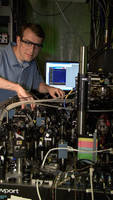NIST demonstrates programmable quantum information processor.
Share:

Press Release Summary:

NIST physicists demonstrated first universal programmable quantum information processor able to run any program allowed by quantum mechanics, using 2 quantum bits (qubits) of information. Processor stores binary information in 2 beryllium ions held in electromagnetic trap and manipulated with UV lasers, while 2 magnesium ions in trap help cool beryllium ions. Scientists are able to place ions in superposition of 1 and 0 values simultaneously as well as entangle both qubits.
Original Press Release:
NIST Demonstrates 'Universal' Programmable Quantum Processor
Physicists at the National Institute of Standards and Technology (NIST) have demonstrated the first "universal" programmable quantum information processor able to run any program allowed by quantum mechanics-the rules governing the submicroscopic world-using two quantum bits (qubits) of information. The processor could be a module in a future quantum computer, which theoretically could solve some important problems that are intractable today.
The NIST demonstration, described in Nature Physics,* marks the first time any research group has moved beyond demonstrating individual tasks for a quantum processor-as done previously at NIST and elsewhere-to perform programmable processing, combining enough inputs and continuous steps to run any possible two-qubit program.
"This is the first time anyone has demonstrated a programmable quantum processor for more than one qubit," says NIST postdoctoral researcher David Hanneke, first author of the paper. "It's a step toward the big goal of doing calculations with lots and lots of qubits. The idea is you'd have lots of these processors, and you'd link them together.
The NIST processor stores binary information (1s and 0s) in two beryllium ions (electrically charged atoms), which are held in an electromagnetic trap and manipulated with ultraviolet lasers. Two magnesium ions in the trap help cool the beryllium ions.
NIST scientists can manipulate the states of each beryllium qubit, including placing the ions in a "superposition" of both 1 and 0 values at the same time, a significant potential advantage of information processing in the quantum world. Scientists also can "entangle" the two qubits, a quantum phenomenon that links the pair's properties even when the ions are physically separated.
The NIST team performed 160 different processing routines on the two qubits. Although there are an infinite number of possible two-qubit programs, this set of 160 is large and diverse enough to fairly represent them, Hanneke says, making the processor "universal." The researchers used a random number generator to select the particular routines that would be executed, so all possible programs had an equal chance of selection. The random programs avoided the possibility of bias in testing the processor in the event that some programs ran better or produced more accurate outputs than others. Each program operated accurately an average of 79 percent of the time across 900 runs, each run lasting about 37 milliseconds. To evaluate the processor and the quality of its operation, NIST scientists compared the measured outputs of the programs to idealized, theoretical results.
The programs did not perform easily described mathematical calculations. Rather, they involved various single-qubit "rotations" and two-qubit entanglements. As an example of a rotation, if a qubit is envisioned as a dot on a sphere at the north pole for 0, at the south pole for 1, or on the equator for a balanced superposition of 0 and 1, the dot might be rotated to a different point on the sphere, perhaps from the northern to the southern hemisphere, making it more of a 1 than a 0.
If they can be built, quantum computers have many possible applications such as breaking today's most widely used encryption codes, such as those that protect electronic financial transactions. In addition to its possible use as a module of a quantum computer, the new processor might be used as a miniature simulator for interactions in any quantum system that employs two energy levels, such as the two-level ion qubit systems that represent energy levels as 0s and 1s. Large quantum simulators could, for example, help explain the mystery of high-temperature superconductivity, the transmission of electricity with zero resistance at temperatures that may be practical for efficient storage and distribution of electric power.
The research was supported in part by the Defense Advanced Research Projects Agency, National Security Agency, and Intelligence Advanced Research Projects Activity.
For more details, read the NIST Nov. 14 news release "NIST Demonstrates 'Universal' Programmable Quantum Processor for Quantum Computers."
* D. Hanneke, J.P. Home, J.D. Jost, J.M. Amini, D. Leibfried and D.J. Wineland. Realization of a programmable two-qubit quantum processor. Nature Physics. Posted online Nov. 15.
Media Contact: Laura Ost, laura.ost@nist.gov, (303) 497-4880




